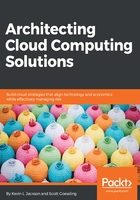
User characteristics
Clouds are like children. They have unique personalities, quirks, strengths, and weaknesses. No two are the same. Just like children, and like some siblings, they behave differently and seem to follow different rules, and sometimes, they misbehave at the worst time.
Cloud solutions are specific to each provider. Successful transitions require due diligence and a thorough understanding of the cloud provider. Cloud transitions require the consumer to know the provider more than the provider needing a deep understanding of the consumer. The traditional IT acquisition process begins with the consumer providing all of the details and requirements for inspection by the provider. The provider then responds with a proposed design that meets said requirements. Cloud solution acquisition cycles now reverse that thinking. Up front, service providers must effectively communicate their capabilities, characteristics, attributes, and supporting services for consideration by consumers. This complete reversal in process and approach is core to the cultural challenge associated with cloud transitions. Strategic, economic, and technical choices are now completely held by the consumer side. Previously, service providers were responsible for nearly all solution due diligence, making recommendations, controlling solution economics, and in nearly all cases conservatively over-engineering solutions as excess capacity was better than too little when needed.
The examination of several characteristics and attributes is now the responsibility of the consumer. These investigative deep-pes often require internal cooperation, and often unwanted politics, across multiple organizations and pisions. The service providers are also adapting in real time as they are now required to share deeper-level detail on how solutions are designed, built, supported, and maintained. Some details potentially requiring additional investigation may include the following:
- Application characteristics
- Application dependencies
- API requirements
- Technology service consumption requirements
- Consuming organization's ability to support IT automation
- Consuming organization's use of scalable design techniques
- Consuming organization's data security and control requirements
- Consuming organization's transformational readiness
Cloud architecture starts by understanding the end user. Cloud service providers use targeted utilization and usage patterns to guide their infrastructure designs. Consumers gain value from a provider's service only if that consumer's operational patterns match the provider's target.
Economy of scale is how CSPs create profit margin. To accomplish this, resource pools are used to share resources across multiple tenants. Both physical and virtual resources are dynamically provisioned and de-provisioned based on user demand. Resource pooling also provides location persity. For SaaS, the user has no control or knowledge of hardware location. In some cases, the consumer can specify general location aspects such as country or region.
Cloud computing economics typically uses virtualization to automate information technology resource provisioning. This often leads to an assumption that virtualization defines cloud computing. In truth, cloud computing economic depends on customer population metrics, namely the Number of Unique Customer Sets (n), Customer Set Duty Cycles (λ,f), Relative Duty Cycle Displacement (t) and Customer Set Load (L):

These metrics set the minimum physical IT resource requirements needed to serve a specified maximum level of demand. The preceding figure illustrates this concept. While the three scenarios show different customer sets, each demanding a 1-unit maximum load, and the consumer demand duty cycles are similar, the duty cycle displacement values in each scenario are different. This small difference translates into significant operational differences:
- Maximum demand in Scenario A and Scenario B is 30% more than that in Scenario C.
- Scenario B has a zero minimum demand.
- Scenario C transitive load requirements are 50% less than the other two.
- If each user set inpidually owned their resources, three units would be required. Scenario A and Scenario B would require the same total number of units. Scenario C, on the other hand, would only need a maximum of 2 units to support the same demand, resulting in a 30% resource savings.
In leveraging the cloud economic model, CSPs must continuously monitor key user metrics in near real time to enable any required changes in the underlying physical infrastructure. This leads to the desired illusion of infinite resources that is characteristic of the cloud computing service experience:

Understanding and knowledge of target user base characteristics will enable a better solution design. The most appropriate service providers are those that provide the best cost and benefit during critical operational periods and duration. If implemented correctly, the cloud computing economic model can materially improve return on investment over on-premises deployments. The preceding figure illustrates this model in a private cloud construct. A 2009 Booz Allen Hamilton study concluded that a cloud computing strategy could save from 50%-67% on the life cycle cost of a 1,000-server deployment.
The study also showed increased benefit-cost ratios when the cloud transition included more servers or a faster migration schedule, as shown in the following figure. A separate Deloitte study shows that cloud deployments deliver more return on investment with shorter payback periods when compared to the traditional data center option:

A cloud solution architect should make every attempt to document and verify the following user population characteristics:
- The expected number of concurrent users for every application or service
- User growth rates over an annual period
- The variability of user demand and for any apparent temporal cycle (that is, time of day, day of the week, week of the month, month of the year)
- User consumption differences based on the user's geographic location
- Breadth across the population and frequency in the use of mobile devices and mobile applications
- Types, models, and operating systems of mobile devices used
- Device ownership options
- Variability of user characteristics based on functional entity association, including any economic variable measured or tracked by separate organizational entities or consolidated across the entire user base
- Important business continuity or disaster recovery concerns are driven by end user location, end user devices, operational process considerations, or the usage cycle